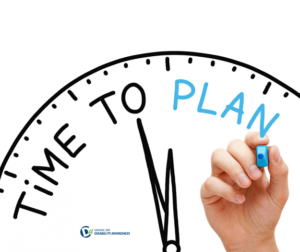- Your sources of income, monthly expenses and lifestyle
- The impact a long-term disability could have on them
- Preparing a plan of action to address the crisis
Step 1. Complete the Income/Expense Review if you have not done so already
The first step is getting a clear picture of where your money is coming from and where it’s going. Our financial calculator makes it simple.
Step 2. Adjust your expenses Once you’ve completed your Income/Expense Review, you may discover that a disability could turn your expenses “upside-down.” In other words, your expenses would exceed your income. So Step 2 is looking for ways to reduce spending. Where could you cut?
- Restaurants
- Entertainment
- Cable TV
- Vacations
- Club and gym memberships
- What else?
Step 3. Find Additional Sources of Income
 Now that you’ve pruned unnecessary spending, it’s time to look for alternate sources of income. Without your usual paycheck, you’ll need extra money to help you and your loved ones weather the financial storm.
Now that you’ve pruned unnecessary spending, it’s time to look for alternate sources of income. Without your usual paycheck, you’ll need extra money to help you and your loved ones weather the financial storm.
Here are some other potential sources of income to explore if you become disabled.
- Employer Sick Pay
Does your employer have sick pay programs for employees? Eligibility and payments vary from company to company. It’s important to know in advance what payments might be available to you if you can’t work. Ask your human resources manager for program details. - Disability Insurance Benefits
Disability insurance can be an invaluable lifeline for disabled workers and their families.- If your employer offers disability insurance make sure you fully understand what benefits are available to you and how your company’s disability insurance program works.
- If disability insurance is NOT provided by your employer, it can be purchased individually at affordable rates. Contact your insurance agent for more information.
- Self-employed individuals can also benefit greatly by having disability insurance. Consult your financial advisor or insurance agent for assistance.
- Social Security Disability Insurance (SSDI) and Workers’ Compensation
These two programs form the cornerstones of financial security for a majority of disabled American workers.- Social Security
If you become disabled, you may qualify for disability benefits through the Social Security Disability Insurance program. However, there is usually a six-month waiting period before SSDI benefits begin. Your eligibility and benefits are based on the number of years you’ve been contributing to Social Security via withholding from your pay. Visit the Social Security website for more information. - Workers’ Compensation
If you’re injured at work or suffer a work-related illness, you may qualify for workers’ compensation benefits. These benefits can help pay for the medical care and rehabilitation needed to help you return to work.
After a short waiting period, workers’ compensation generally pays a portion of your former wages or salary. Benefits vary significantly by state and are restricted to a specific maximum and minimum amount. For links to your state’s workers’ compensation program, go to: www.workerscompensation.com.
- Social Security
- Personal savings
A small percentage of Americans are lucky enough to have savings, investments or other financial resources that can supplement or replace their income during a prolonged disability. The rest of us, unfortunately, are not so lucky. Any disability, especially one lasting more than 90 days, would quickly drain our savings. After all, Americans’ savings rate is at an all-time low. A full 1/3 of Americans have no retirement savings and no pension, according to the Social Security Administration. Talk about stress! - “Last Resort” income sources
If all else fails, you can begin paying expenses with credit cards, get a second mortgage, take out a home equity line of credit, withdraw money from your retirement plan, and ask family and friends for assistance.
Step 4. Stay Healthy
One of the best ways to reduce your chances of becoming disabled – and enriching your overall quality of life – is by maintaining a healthy lifestyle. Taking responsibility for your fitness and well-being can have a direct beneficial impact on your physical, psychological and financial health. Make sure staying healthy is part of your Personal Financial Security Plan.
Step 5. Take Action
The Income/Expense Review provided an estimate of what your net income would be during a period of disability. Now it’s time to develop your action plan.
- Make a checklist of those specific actions including top priorities and timelines.
- Include a wellness program, develop healthy eating habits and incorporate exercise into your daily lifestyle.
- Update your plan every year your personal and financial circumstances are continually changing.
Whatever your age, it’s never too soon (or too late) to begin. By building a personal financial plan, you and your family will be better prepared to face the future – no matter what it holds.
Source: The Council for Disability Awareness
